Poussin, Nicolas [1594-1665]
Nicolas Poussin, the greatest French artist of the 17th century, is considered one of the founders of European classicism, a movement in art, based on antique and Renaissance heritage.
Poussin was born in Normandy, in Les-Andelys, in 1594. The son of an impoverished family, Poussin received some early professional training at home. In 1612, Poussin left for Paris, where he entered the workshop of the mannerist painter J. Lallemald. The training was reinforced by independent study of, mainly, Italian art in the Royal Collections. By the end of the 1610s Poussin became an authoritative master, the evidence of this are his commissions for the decoration of the Luxembourg Palace in Paris, and the big altarpiece Assumption of the Virgin. Unfortunately from the works of the first Paris period (1612-23) only drawings based on Ovid’s Metamorphosis survived.
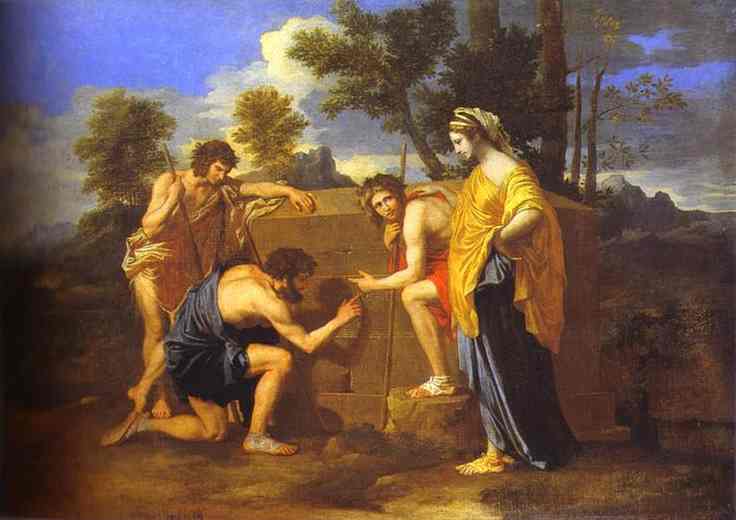 The Shepherds of Arcadia. 1638. Oil on canvas. Louvre, Paris, France.
The Shepherds of Arcadia. 1638. Oil on canvas. Louvre, Paris, France.
Arcadia, the central plateau of Peloponnesian peninsular, was in ancient times inhabited by shepherds and hunters, who worshiped Pan, god of flocks and herds. In literature and art Arcadia was idealized and turned into a pastoral paradise ruled by Pan and inhabited by carefree shepherds and shepherdesses, Nymphs, and Satyrs.
The phrase Et in Arcadia ego, which could be found inscribed on some paintings, means ‘even in Arcadia I (i.e. Death) am to be found’, that is even in the earth paradise one can't hide from death.
아르카디아는 전설속에 나오는 고대의 낙원.,"이 세상에 죽음을 피할 곳은 없다. 그러니 삶을 소중히 여겨야 한다." 구에르치노의 1618년 작품 역시 같은 제목인데, 부패를 상징하는 파리가 해골위에 앉아있는 작품. 그 광경을 두명의 목동이 발견한다. 영원한 생명의 축복이 있는 아르카디아에도 죽음의 증거가 발견되었다. 니콜라스 푸생은 중세 시대 기술을 이용한다. 젊은이 중년, 장년에 이르는 같은 인물을 무덤과 가장 가까운 곳에 나이가 많이 든 순서대로 배치한다. 그리고 그 옆에는 대지의 여신 미네르바가...
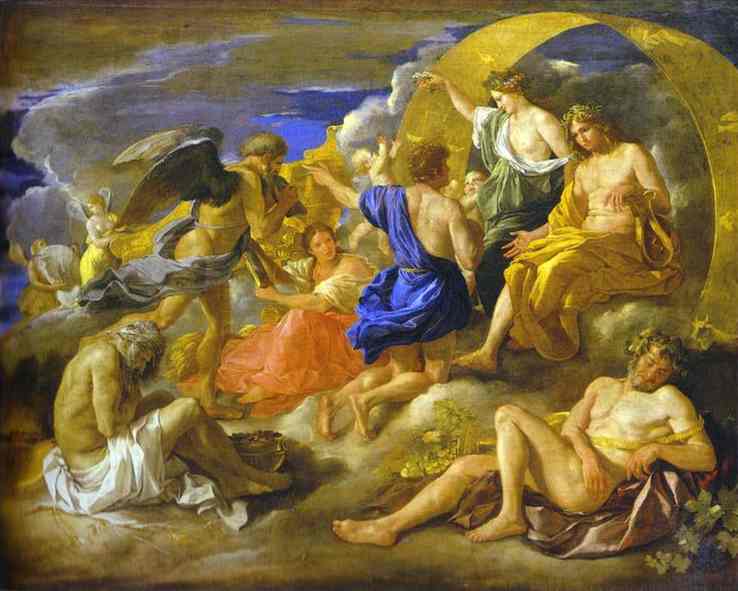 Helios and Phaeton with Saturn and the Four Seasons. c. 1629-30. Oil on canvas. Gemaldegalerie, Berlin, Germany
Helios and Phaeton with Saturn and the Four Seasons. c. 1629-30. Oil on canvas. Gemaldegalerie, Berlin, Germany
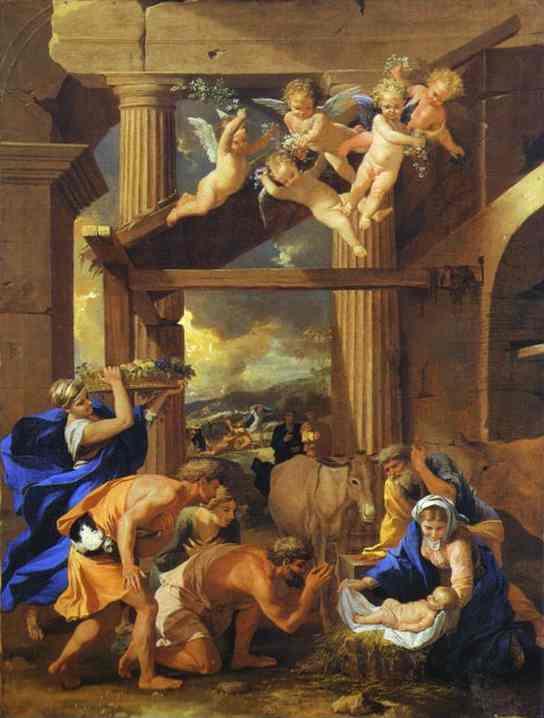 Adoration of the Shepherds. 1633. Oil on canvas. National Gallery, London, UK.
Adoration of the Shepherds. 1633. Oil on canvas. National Gallery, London, UK.
Adoration of the Shepherds. The Gospel of Luke (2:8-20) tells that on the night Mary gave birth to Jesus Christ, an angel announced the Good News to the shepherds: 'Now in this same district there were shepherds out in the field, keeping watch through the night over their flock', they were terrified when they saw the angel of the Lord, but the angel said: 'Do not be afraid; I bring you good news, new of great joy for the whole nation. Today there has been born to you in the city of David a deliverer - the Messiah, the Lord.' (Luke 2:8-12). After the angel had left them, the shepherds hurried to greet and worship the Child.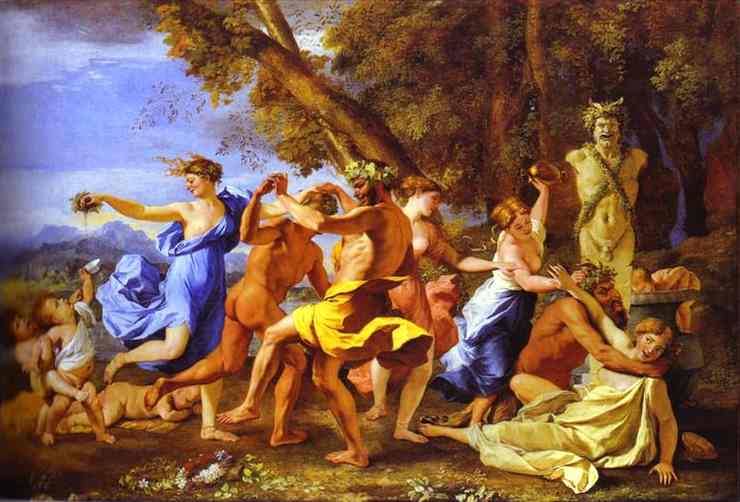 Bacchanalia. 1631-1633. Oil on canvas. National Gallery, London, UK.
Bacchanalia. 1631-1633. Oil on canvas. National Gallery, London, UK.
Dionysus (Roman name Bacchus), Greek Olympian god of vine, wine and mystic ecstasy. Orgies in favor of Bacchus are bacchanals. According to classical mythology, the god’s favorite island was Andros, where rivers ran with wine instead of water. The Greek city of Amphissa, or Salona, was also a center for the cult of Dionysus. Triumph of Neptune and Amphitrite. 1634. Oil on canvas. Philadelphia Museum of Art. Philadelphia, PA, USA.
Triumph of Neptune and Amphitrite. 1634. Oil on canvas. Philadelphia Museum of Art. Philadelphia, PA, USA.
Poseidon (his latin name Neptune) the god of the sea and its inhabitants, and one of the Olympians, the son of Cronus and Rhea, brother of Zeus, Hades, Demeter, Hera, Hestia. He was married to Amphitrite, a Nereid, and had by her the son Triton, a merman. Like other Olympians, had many love affairs and numerous children.
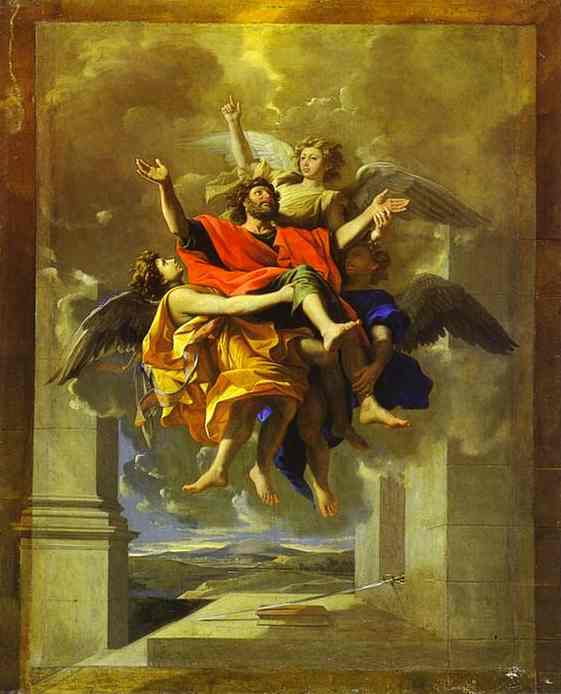 The Ecstasy of St. Paul. 1643. Oil on canvas. Louvre, Paris, France
The Ecstasy of St. Paul. 1643. Oil on canvas. Louvre, Paris, France
St. Paul (Apostle). After Christ himself, St. Paul is the second most important figure in the history of Christianity. His life is known through the Acts of the Apostles and through his own writings. Although he never knew Jesus, he is nonetheless called an apostle (disciple). St. Paul was born around A.D.10, at Tarsus, in Asia Minor. He was called Saul, after his conversion he changed his name into Paul (Latin paulus means small).
Saul, an enemy to Christians, asked the high priests to authorize him to arrest Christians at Damascus and bring them back to Jerusalem. On his way to Damascus at the head of his armed men Saul fell to the ground when he heard the voice of Christ, saying: 'Saul, Saul, why do you persecute me?' and temporarily lost his sight. And he said, 'Who art thou, Lord? And the Lord said, I am Jesus whom thou persecutest... And he trembling and astonished said, Lord, what wilt thou have me do? And the Lord said unto him, Arise and go into city, and it shall be told thee what thou must do. And the men which journeyed with him stood speechless, hearing a voice, but seeing no man' (Acts 9:5-7). Saul got up from the ground, but could not see, and his men brought him to Damascus. There he stayed in the house of Judas in the Straight Street. To that house the Lord sent a disciple named Ananias to heal Saul. Ananias came to the house, laid his hands on Saul and said, 'Saul, my brother, the Lord Jesus, who appeared to you on your way here, has sent me to you so that you may recover your sight and be filled with the Holy Spirit' (Acts 9:17). And his sight returned to Saul, and he got baptized.
On his return to Jerusalem Paul found Peter and other disciples and was accepted into the Christian community. He traveled all over the Roman Empire on missionary voyages. At length he arrived in Rome, where he again joined Peter. Emperor Nero, around A.D. 64, martyred them both during the persecutions of Christians. Paul as a Roman citizen was beheaded; Peter was crucified like a slave. Paul is considered to be the founder of the Universal Church since he not only took the Gospel to all corners of the Roman Empire, but also separated Christianity once and for all from Judaism. His cult has always been linked to that of St. Peter and numerous churches are dedicated simultaneously to both saints.
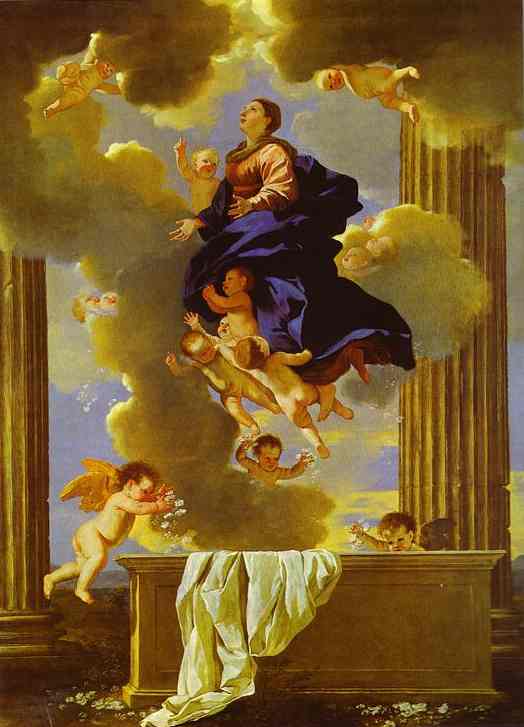 The Assumption of the Virgin. c. 1638. Oil on canvas. The National Gallery of Art, Washington, DC, USA.
The Assumption of the Virgin. c. 1638. Oil on canvas. The National Gallery of Art, Washington, DC, USA.
Virgin Mary (Madonna), the mother of Jesus Christ. Only part of her legend can be found in the Gospels (of Matthew and of Luke), many facts of her life were written later, and her cult was established only in the late Middle Ages. The fullest account of her life could be found in The Golden Legend, a collection of apocryphal texts, and saints' legends published in Latin in the 13th century by the Dominican Jacob da Voragine, Archbishop of Genoa.
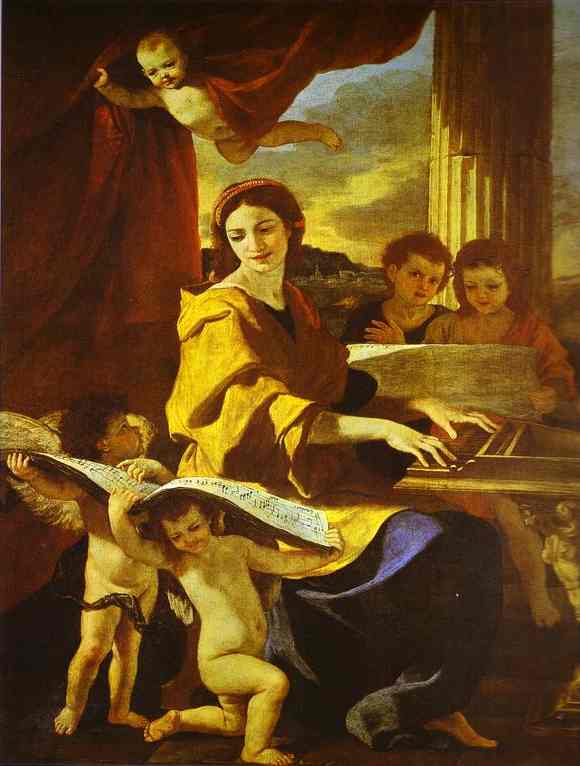 St. Cecilia. c.1627-28. Oil on canvas. Museo del Prado, Madrid, Spain.
St. Cecilia. c.1627-28. Oil on canvas. Museo del Prado, Madrid, Spain.
St. Cecilia lived in the 2nd or 3rd century A.D. A young girl of noble origin, she was betrothed to a noble Roman, Valerius. She converted him to Christianity and persuaded both him and his brother to be baptized. She then refused to undergo pagan rituals and was sentenced to death. She managed to survive the first torture, then the torturers tried to behead her, but only managed to mutilate her and she lasted for 3 days before dying.
Since the 16th century Cecilia has been known as the patron of musicians. In fine art she is often depicted with a musical instrument.
Feast day: 22 November.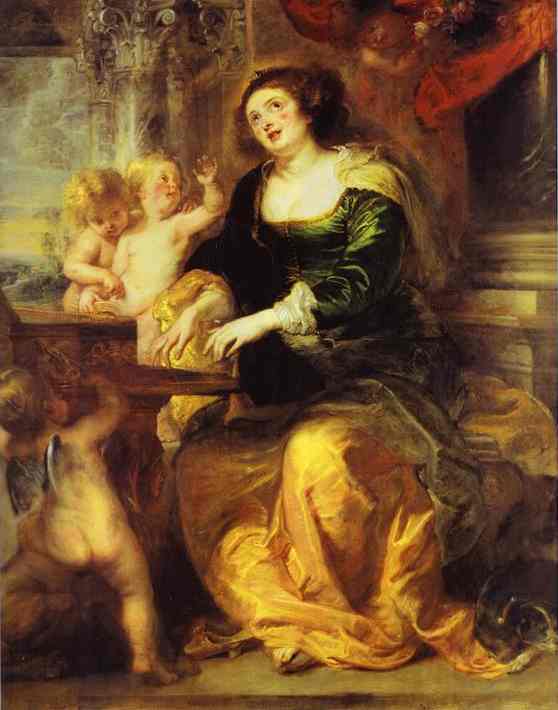 Peter Paul Rubens. St. Cecilia. c.1639-1640. Oil on panel. Gemaldegalerie, Berlin, Germany
Peter Paul Rubens. St. Cecilia. c.1639-1640. Oil on panel. Gemaldegalerie, Berlin, Germany
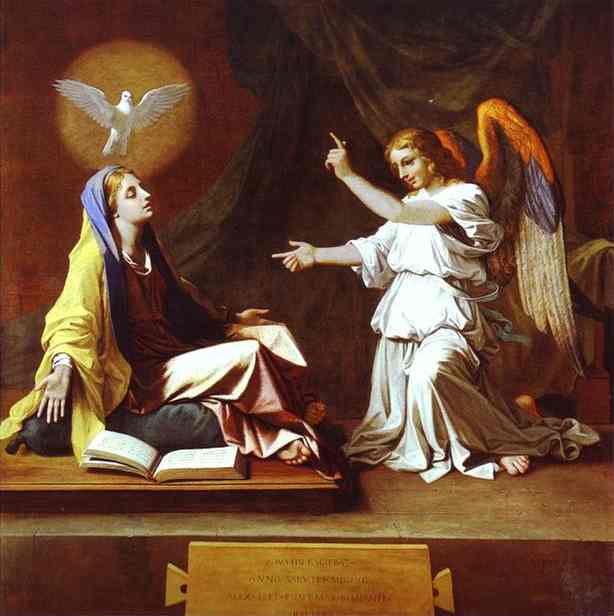 The Annunciation. c.1655. Oil on canvas. National Gallery, London, UK
The Annunciation. c.1655. Oil on canvas. National Gallery, London, UK
Mary (Madonna), the mother of Jesus Christ. Only part of her legend can be found in the Gospels (of Matthew and of Luke), many facts of her life were written later, and her cult was established only in the late Middle Ages. The fullest account of her life could be found in The Golden Legend, a collection of apocryphal texts, and saints' legends published in Latin in the 13th century by the Dominican Jacob da Voragine, Archbishop of Genoa.
Georges de LA TOUR
바니타스 정물:
Memento Mori : 죽음의 경고, 죽음을 기억하라
해골- 피할 수 없는 숙명
플릇, 악보- 짧은 순간의 기쁨
거품, 유리잔- 인생의 허무
모래시계 , 촛불,
(정물화는 결국 인간의 욕망, 탐욕, 허영)--종교화와 대립.
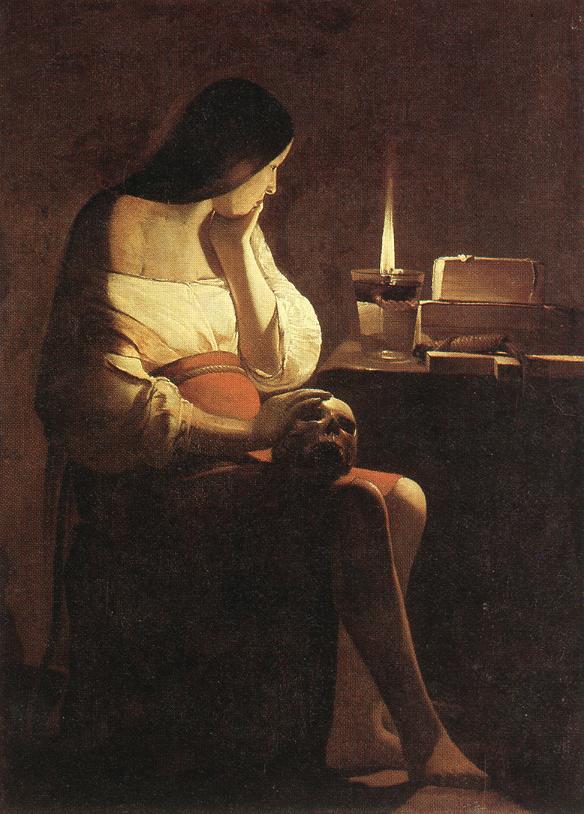 Magdalen of Night Light
Magdalen of Night Light
1630-35
Oil on canvas, 128 x 94 cm
Musée du Louvre, Paris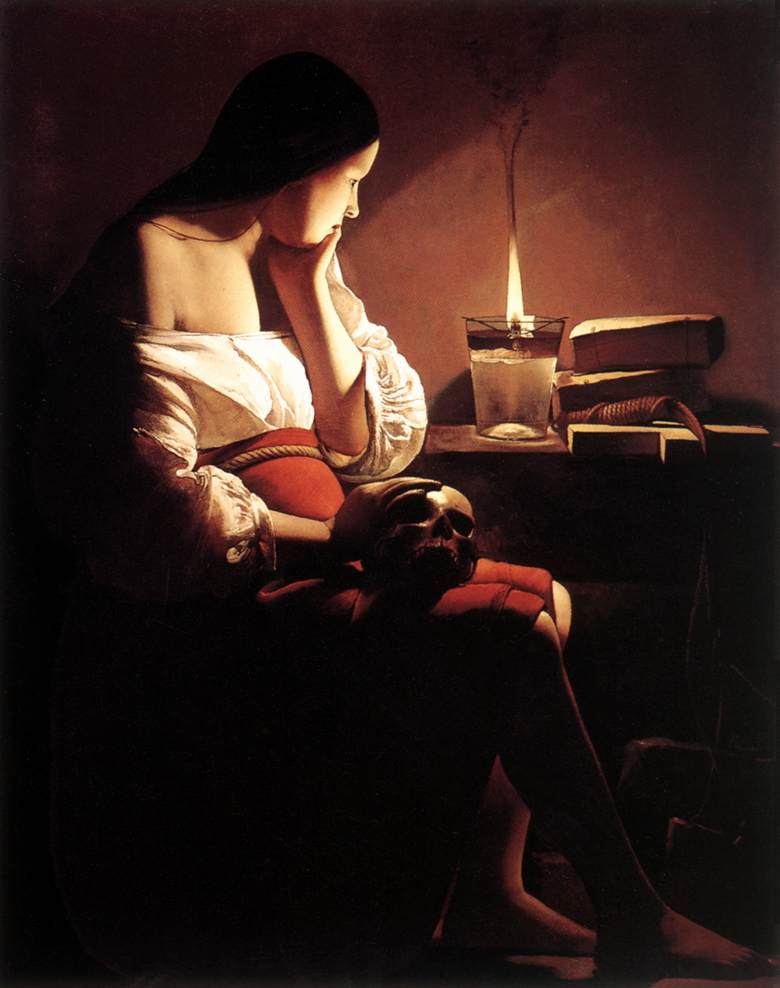 Magdalen with the Smoking Flame
Magdalen with the Smoking Flame
c. 1640
Oil on canvas, 117 x 91,8 cm
County Museum of Art, Los Angeles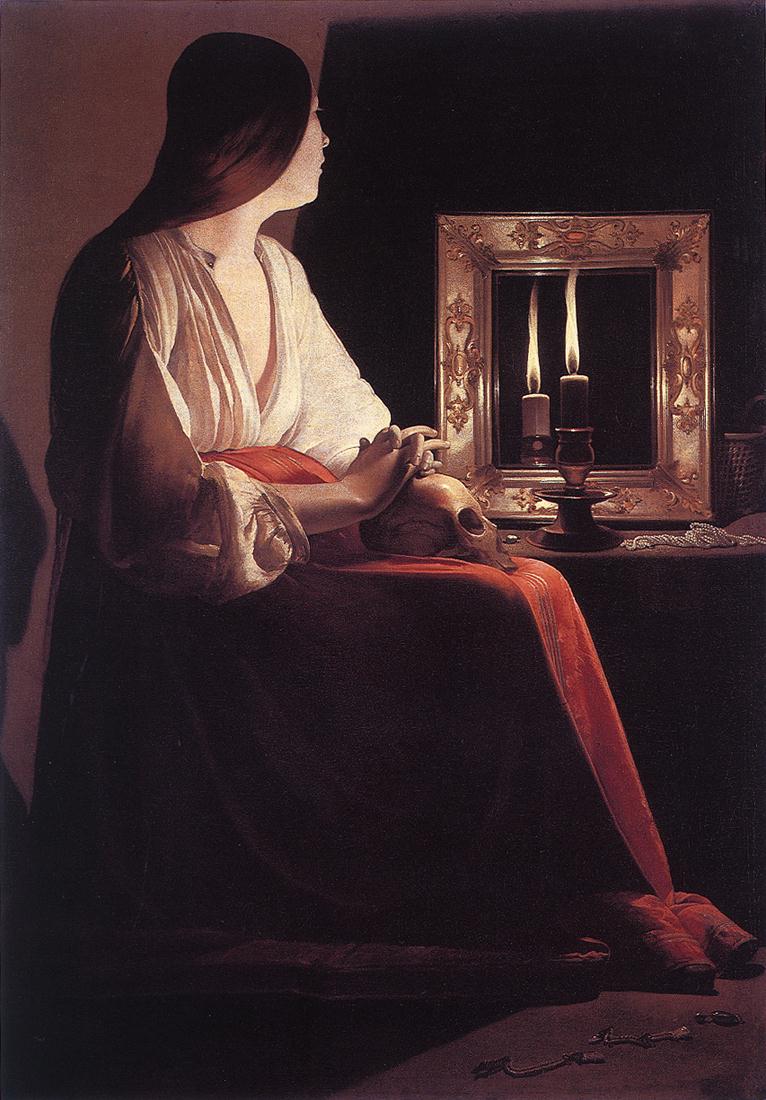 The Penitent Magdalen
The Penitent Magdalen
1638-43
Oil on canvas, 133,4 x 102,2 cm
Metropolitan Museum of Art, New York
Nicolas Poussin, the greatest French artist of the 17th century, is considered one of the founders of European classicism, a movement in art, based on antique and Renaissance heritage.
Poussin was born in Normandy, in Les-Andelys, in 1594. The son of an impoverished family, Poussin received some early professional training at home. In 1612, Poussin left for Paris, where he entered the workshop of the mannerist painter J. Lallemald. The training was reinforced by independent study of, mainly, Italian art in the Royal Collections. By the end of the 1610s Poussin became an authoritative master, the evidence of this are his commissions for the decoration of the Luxembourg Palace in Paris, and the big altarpiece Assumption of the Virgin. Unfortunately from the works of the first Paris period (1612-23) only drawings based on Ovid’s Metamorphosis survived.

Arcadia, the central plateau of Peloponnesian peninsular, was in ancient times inhabited by shepherds and hunters, who worshiped Pan, god of flocks and herds. In literature and art Arcadia was idealized and turned into a pastoral paradise ruled by Pan and inhabited by carefree shepherds and shepherdesses, Nymphs, and Satyrs.
The phrase Et in Arcadia ego, which could be found inscribed on some paintings, means ‘even in Arcadia I (i.e. Death) am to be found’, that is even in the earth paradise one can't hide from death.
아르카디아는 전설속에 나오는 고대의 낙원.,"이 세상에 죽음을 피할 곳은 없다. 그러니 삶을 소중히 여겨야 한다." 구에르치노의 1618년 작품 역시 같은 제목인데, 부패를 상징하는 파리가 해골위에 앉아있는 작품. 그 광경을 두명의 목동이 발견한다. 영원한 생명의 축복이 있는 아르카디아에도 죽음의 증거가 발견되었다. 니콜라스 푸생은 중세 시대 기술을 이용한다. 젊은이 중년, 장년에 이르는 같은 인물을 무덤과 가장 가까운 곳에 나이가 많이 든 순서대로 배치한다. 그리고 그 옆에는 대지의 여신 미네르바가...


Adoration of the Shepherds. The Gospel of Luke (2:8-20) tells that on the night Mary gave birth to Jesus Christ, an angel announced the Good News to the shepherds: 'Now in this same district there were shepherds out in the field, keeping watch through the night over their flock', they were terrified when they saw the angel of the Lord, but the angel said: 'Do not be afraid; I bring you good news, new of great joy for the whole nation. Today there has been born to you in the city of David a deliverer - the Messiah, the Lord.' (Luke 2:8-12). After the angel had left them, the shepherds hurried to greet and worship the Child.

Dionysus (Roman name Bacchus), Greek Olympian god of vine, wine and mystic ecstasy. Orgies in favor of Bacchus are bacchanals. According to classical mythology, the god’s favorite island was Andros, where rivers ran with wine instead of water. The Greek city of Amphissa, or Salona, was also a center for the cult of Dionysus.

Poseidon (his latin name Neptune) the god of the sea and its inhabitants, and one of the Olympians, the son of Cronus and Rhea, brother of Zeus, Hades, Demeter, Hera, Hestia. He was married to Amphitrite, a Nereid, and had by her the son Triton, a merman. Like other Olympians, had many love affairs and numerous children.

St. Paul (Apostle). After Christ himself, St. Paul is the second most important figure in the history of Christianity. His life is known through the Acts of the Apostles and through his own writings. Although he never knew Jesus, he is nonetheless called an apostle (disciple). St. Paul was born around A.D.10, at Tarsus, in Asia Minor. He was called Saul, after his conversion he changed his name into Paul (Latin paulus means small).
Saul, an enemy to Christians, asked the high priests to authorize him to arrest Christians at Damascus and bring them back to Jerusalem. On his way to Damascus at the head of his armed men Saul fell to the ground when he heard the voice of Christ, saying: 'Saul, Saul, why do you persecute me?' and temporarily lost his sight. And he said, 'Who art thou, Lord? And the Lord said, I am Jesus whom thou persecutest... And he trembling and astonished said, Lord, what wilt thou have me do? And the Lord said unto him, Arise and go into city, and it shall be told thee what thou must do. And the men which journeyed with him stood speechless, hearing a voice, but seeing no man' (Acts 9:5-7). Saul got up from the ground, but could not see, and his men brought him to Damascus. There he stayed in the house of Judas in the Straight Street. To that house the Lord sent a disciple named Ananias to heal Saul. Ananias came to the house, laid his hands on Saul and said, 'Saul, my brother, the Lord Jesus, who appeared to you on your way here, has sent me to you so that you may recover your sight and be filled with the Holy Spirit' (Acts 9:17). And his sight returned to Saul, and he got baptized.
On his return to Jerusalem Paul found Peter and other disciples and was accepted into the Christian community. He traveled all over the Roman Empire on missionary voyages. At length he arrived in Rome, where he again joined Peter. Emperor Nero, around A.D. 64, martyred them both during the persecutions of Christians. Paul as a Roman citizen was beheaded; Peter was crucified like a slave. Paul is considered to be the founder of the Universal Church since he not only took the Gospel to all corners of the Roman Empire, but also separated Christianity once and for all from Judaism. His cult has always been linked to that of St. Peter and numerous churches are dedicated simultaneously to both saints.

Virgin Mary (Madonna), the mother of Jesus Christ. Only part of her legend can be found in the Gospels (of Matthew and of Luke), many facts of her life were written later, and her cult was established only in the late Middle Ages. The fullest account of her life could be found in The Golden Legend, a collection of apocryphal texts, and saints' legends published in Latin in the 13th century by the Dominican Jacob da Voragine, Archbishop of Genoa.

St. Cecilia lived in the 2nd or 3rd century A.D. A young girl of noble origin, she was betrothed to a noble Roman, Valerius. She converted him to Christianity and persuaded both him and his brother to be baptized. She then refused to undergo pagan rituals and was sentenced to death. She managed to survive the first torture, then the torturers tried to behead her, but only managed to mutilate her and she lasted for 3 days before dying.
Since the 16th century Cecilia has been known as the patron of musicians. In fine art she is often depicted with a musical instrument.
Feast day: 22 November.


Mary (Madonna), the mother of Jesus Christ. Only part of her legend can be found in the Gospels (of Matthew and of Luke), many facts of her life were written later, and her cult was established only in the late Middle Ages. The fullest account of her life could be found in The Golden Legend, a collection of apocryphal texts, and saints' legends published in Latin in the 13th century by the Dominican Jacob da Voragine, Archbishop of Genoa.
Georges de LA TOUR
바니타스 정물:
Memento Mori : 죽음의 경고, 죽음을 기억하라
해골- 피할 수 없는 숙명
플릇, 악보- 짧은 순간의 기쁨
거품, 유리잔- 인생의 허무
모래시계 , 촛불,
(정물화는 결국 인간의 욕망, 탐욕, 허영)--종교화와 대립.

1630-35
Oil on canvas, 128 x 94 cm
Musée du Louvre, Paris

c. 1640
Oil on canvas, 117 x 91,8 cm
County Museum of Art, Los Angeles

1638-43
Oil on canvas, 133,4 x 102,2 cm
Metropolitan Museum of Art, New York
'History of Arts > Baroque & Rococo' 카테고리의 다른 글
| 바로크 - Espagne (0) | 2007.10.02 |
|---|---|
| 바로크Baroque (1600-1790)- Pays-Bas (1) | 2007.10.01 |
| 바로크 건축 (3) | 2007.10.01 |
| 매너리즘 (1) | 2007.10.01 |
| 벨라스케스 이탈리아 바로크 (0) | 2007.05.26 |



